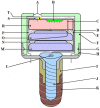A New Model of Salivary Pacemaker-A Proof of Concept and First Clinical Use
- PMID: 37763766
- PMCID: PMC10535961
- DOI: 10.3390/medicina59091647
A New Model of Salivary Pacemaker-A Proof of Concept and First Clinical Use
Abstract
Background and Objectives: Saliva is of utmost importance for maintaining oral health. Management of saliva flow rate deficiency recently includes salivary neuro-electrostimulation. The aim of this paper is to present a new model of salivary pacemaker-the MICROSAL device (MD), an intelligent, miniaturized, and implant-supported oral device used for salivary stimulation. Materials and Methods: This report presents the development, calibration, and first clinical tests which involved the MD. The novel features of this device are the pH sensor and the fact that it communicates with the patient's smartphone, where oral wetness and pH are graphically exposed. Saliva samples were taken before and after the MD was used on a 68-year-old patient suffering from post-irradiation xerostomia, and albumin and total protein were analyzed. Results: The device uses up to 3 V and time intervals of 2 s seconds for stimulation. The total volume of all saliva samples collected during the clinical trial was almost seven times higher after the device was used. Albumin decreased from a maximum of 0.15 g/dL to 0.04 g/dL, and total proteins from 0.65 g/dL to 0.21 g/dL, after salivary stimulation. Conclusions: The MD increased saliva secretion of the patient, and we are confident it will be a good solution for future management of salivary gland hypofunction.
Keywords: dental implant; salivary secretion device; xerostomia.
Conflict of interest statement
The authors declare no conflict of interest. The funders had no role in the design of the study; in the collection, analyses, or interpretation of data; in the writing of the manuscript, or in the decision to publish the results.
Figures




Similar articles
-
Implant-supported electrostimulating device to treat xerostomia: a preliminary study.Clin Implant Dent Relat Res. 2010 Mar;12(1):62-71. doi: 10.1111/j.1708-8208.2009.00180.x. Epub 2009 Aug 9. Clin Implant Dent Relat Res. 2010. PMID: 19681934
-
Salivary stimulatory effect of novel low level transcutaneous electro neurostimulator in geriatric patients with xerostomia.BMC Oral Health. 2023 May 28;23(1):334. doi: 10.1186/s12903-023-03049-0. BMC Oral Health. 2023. PMID: 37246232 Free PMC article.
-
Current therapies for xerostomia and salivary gland hypofunction associated with cancer therapies.Support Care Cancer. 2003 Apr;11(4):226-31. doi: 10.1007/s00520-002-0409-5. Epub 2002 Oct 22. Support Care Cancer. 2003. PMID: 12673460 Review.
-
A Study on Duration of Effect of Transcutaneous Electrical Nerve Stimulation Therapy on Whole Saliva Flow.J Contemp Dent Pract. 2015 Jun 1;16(6):479-85. doi: 10.5005/jp-journals-10024-1710. J Contemp Dent Pract. 2015. PMID: 26323452
-
[Oral medicine 2. Treatment of dry mouth].Ned Tijdschr Tandheelkd. 2012 Nov;119(11):555-60. doi: 10.5177/ntvt.2012.11.11246. Ned Tijdschr Tandheelkd. 2012. PMID: 23236740 Review. Dutch.
References
-
- Gupta A., Epstein J.B., Sroussi H. Hyposalivation in elderly patients. J. Can. Dent. Assoc. Tor. 2006;72:841–846. - PubMed
-
- Villa A., Wolff A., Aframian D., Vissink A., Ekström J., Proctor G., McGowan R., Narayana N., Aliko A., Sia Y.W., et al. World Workshop on Oral Medicine VI: A systematic review of medication-induced salivary gland dysfunction: Prevalence, diagnosis, and treatment. Clin. Oral Investig. 2015;19:1563–1580. doi: 10.1007/s00784-015-1488-2. - DOI - PubMed
Publication types
MeSH terms
Substances
Grants and funding
LinkOut - more resources
Full Text Sources
Medical

